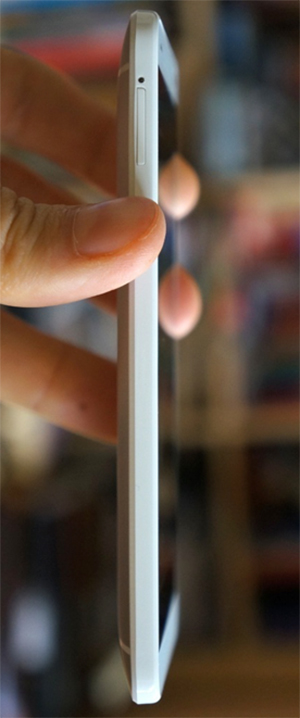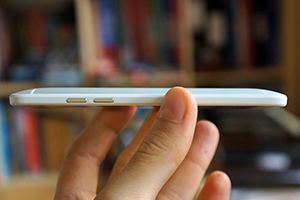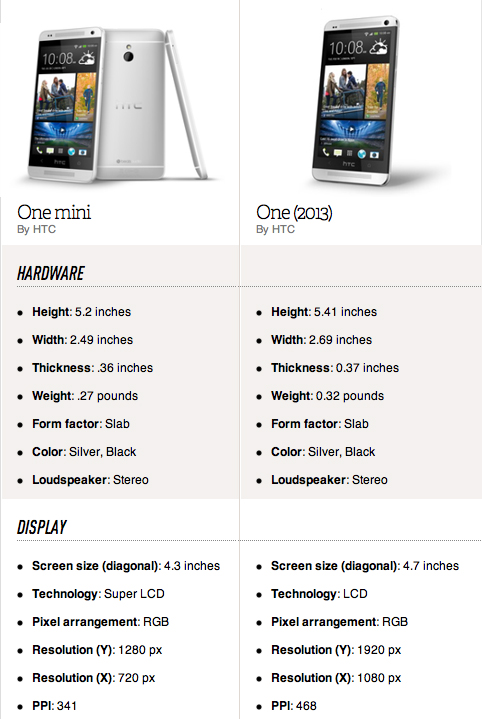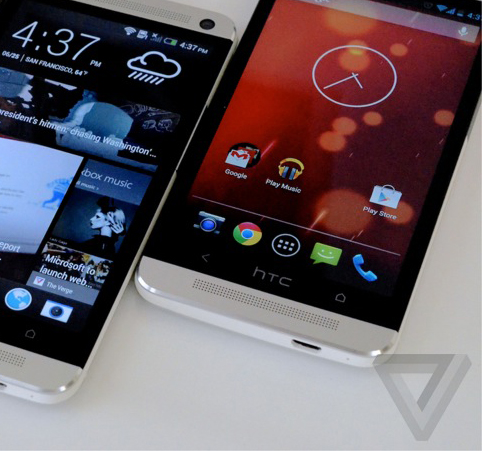Miniaturization is rarely a bad thing in the world of technology, but there’s a fine balance to be struck when trying to make something as small as possible without discarding the traits that made it appealing in the first place. Companies from Apple to Motorola to Samsung have tried their hand at distilling their already successful products into smaller, cheaper, and typically less powerful forms, attempting to deliver a compromise-free flagship experience in a more pocket-friendly size.
HTC believes it’s succeeded at that task with the One mini, which retains the two best things about the original One, namely its superb display quality and a unibody aluminum shell. Plenty of other corners have been cut, in order to fit within a new price bracket as well as within tighter dimensions, so questions about the resulting handset do linger.
Does the trimmed-down One feel as good as the full-fat version? And finally, can we, as Android phone users, come up with a less emasculating title for 4.3-inch phones that don’t suck?
Aluminize your eyes
HTC’s effort to achieve a premium look and feel with the 4.7-inch One was centered on one core ingredient: aluminum. Not by accident, the One mini’s aesthetics stick as close as possible to those of the original, critically acclaimed handset.
The only area where HTC’s lower budget becomes apparent is around the sides of the new phone. They're wrapped in a thick band of glossy white plastic rather than the thin layer of matte white sandwiched between a pair of chamfered aluminum edges on the One. It makes the One mini appear less sophisticated and refined, but on the other hand, the softer plastic surface is friendlier to your palm.
The difference in size and weight is instantly recognizable
You can immediately sense the difference in weight and size between the One mini and One. Pictures fail to do justice to the massive upgrade in ergonomics that the smaller handset represents. That’s right, upgrade. Combining the softer plastic edges with a narrower and lighter body means you can actually use this phone with one hand and little to no strain. Your thumb can comfortably reach every corner of the display and the top-mounted power button will be within reach of most people’s forefinger.
While I wasn’t as enamored with the One’s design as most others, I’ve come to appreciate the aluminum case’s durability after dropping that handset a number of times; that bodes well for the One mini’s long-term endurance and ruggedness. The high precision of the design does leave room for manufacturing faults, however, and I unfortunately found one such imperfection on my review unit. The white light that illuminates the capacitive keys also leaks out of a small gap between the lower BoomSound speaker and the black bezel around the display. It’s not something that will affect the physical integrity of the phone, but can be an eyesore.

720p is no downgrade
When you’re watching movies on a large HDTV, the difference between HD standards can be stark. After all, 1080p content has more than double the pixels you’ll find in 720p video, and everyone knows that greater pixel density is always better. Except when it’s not. Numerically, the One mini is a step down: its 1280 x 720 resolution on a 4.3-inch screen produces a pixel density of 341ppi, far below the One’s eye-popping 468ppi. But once you stray past 300ppi or so (what Apple describes as the "Retina" threshold), pixels just become indistinguishably small and any further upgrades aren't really meaningful.
The One mini reproduces the full excellence of the One’s Super LCD screen, which in itself was building on the outstanding pedigree of the One X display. Color accuracy, contrast, and viewing angles are all superb. If there’s one complaint to be made, it’s that the automatic brightness doesn’t go high enough, making the phone difficult to read in direct sunlight. I’ve had the same experience with the larger One, and you can obviously rectify matters using the manual setting. In short, if you’re after the phone with the best screen on the market today, your choice will be between HTC’s 2013 One models and Apple’s iPhone 5.

Stripping down the spec sheet
The biggest cutbacks in HTC’s budgetary adjustment with the One mini are in the internal specs. You get a dual-core 1.4GHz Snapdragon processor, 1GB of RAM, and 16GB of non-expandable storage. That’s half the cores, half the memory, and half the storage, suggesting that this handset might more aptly have been called the HTC One demi. Nevertheless, change to those components is meaningless to the end user unless it impacts performance, and with the One mini it really doesn’t. There’s no denying that the HTC One has the higher performance ceiling, however in the vast majority of day-to-day tasks the One mini matches it step for step. UI animations are just as fluid, browser performance is identical — even on more complex and content-rich websites like The Verge — and the camera’s capabilities and processing times are indistinguishable.
Other hardware features you’ll find on the One but not on the One mini include NFC, an IR blaster, and optical image stabilization (OIS) for the camera. I don’t believe any of them are of material importance — there are so far few NFC applications that can’t be replicated by more conventional means, the IR blaster was a gimmick from the start, and OIS would only have mattered if the camera was actually any good (more on that later).
HTC has kept the important things unchanged between One models. LTE connectivity and stereo BoomSound speakers are present and accounted for, with excellent connectivity and audio equal to the larger One.
A smaller battery makes a big impact
Up to this point, the HTC One mini’s spec sheet appears to merely be shorter, not lesser, than the One’s. But there is one important area where the company cut back too far: the battery. Stepping down from 2300mAh on the One to 1800mAh on the One mini translates to a palpable diminution in endurance. That’s bad news since the original handset was already average by Android standards. It’s not that the One mini can’t last a full day with judicious use — it can, particularly with HTC’s Power Saver mode enabled — but it made me anxious to recharge it a lot more often than the One ever did.
HTC’s First handset, released in the US with almost identical specs to the One mini, comes with a 10 percent larger battery and lasts quite a bit longer in practice. I’d happily trade the UltraPixel, Beats, and BoomSound branding on the One mini for the extra stamina of the First.


UltraDisappointing

When HTC first introduced the UltraPixel camera, it earned deserved praise for stepping out of the megapixel race and focusing on image quality instead. It was indeed a bold move to limit resolution to 4 megapixels in an effort to make every pixel larger and therefore capable of collecting more light more quickly. That allows for faster image capture — which in turn minimizes motion blur, whether from the photographer’s shaking hand or subjects moving in the frame — and is indeed something that camera vendors of all creeds should be pursuing. The problem with HTC’s execution is that it wasn’t very good. And it still isn’t.

Almost none of the photos I shot with the One mini can be described as sharp. Softness of detail, even on the areas that are supposed to be in focus, pervades images from this camera, as does a certain hazy appearance that tends to result from taking in too much light. The latter is particularly apparent when shooting sunlit scenes outdoors. Contrast and dynamic range are also pretty weak, whether you’re shooting photos or video.
Few of the photos can be described as sharp

The only laudable thing about the One mini’s camera is HTC’s reliably solid imaging software. It allows you to capture video or photos without switching modes, it can apply filters to images as you take them or afterwards, and it has a basic editing suite that comes in handy. Still, it’s pretty faint praise for a cameraphone to say that you can hide the ugliness of its results via software.

Crying out for a Google Edition
Zoe photos. BlinkFeed. Beats Audio. Sense. Everywhere you look on the One mini, there's overzealous branding of forgettable features. Zoe photos are a cute way to shoot a burst of photos that can then also be turned into very brief video clips. Their purpose and functionality is still pretty convoluted and HTC’s Zoe sharing service is so extensively branded by the company as to put you off ever using it.
Everywhere you look on the One mini, there's overzealous branding of forgettable features
BlinkFeed is yet another attempt at the eternal goal of delivering an all-in-one information aggregator for your home screen. Like Sony’s Timescape and everyone else who has tried this before, BlinkFeed fails. It’s just not customizable or versatile enough to serve a user’s needs in the comprehensive manner that it aspires to. Beats Audio has been a consistently unhelpful addition to HTC phones for nearly two years now and it remains so today. It fattens the bass, makes the high-end more shrill, and generally erodes the quality of your music.
And then there’s Sense.
HTC's tweaks and augmentations to Android are not all bad: there’s a neat set of app shortcuts on the lockscreen, a quick settings submenu in the notifications bar, and the camera suite. The trouble is that these enhancements are only a small proportion of the changes HTC makes to Android’s interface — most of the rest is either deleterious or change for change’s sake. For example, Android already has a decent app drawer and a reasonable way to create home screen shortcuts — why did anyone at HTC need to spend time modifying those?
It’s not that Android cannot be improved upon, far from it. I’ve long been dissatisfied with the default Calendar app, but HTC somehow manages to make it worse in Sense 5. Ultimately, the problem is not that Android is being iterated upon, it’s that Android is being iterated upon badly.
There were a pair of other software foibles that I encountered in my time with the latest Sense. The first, present on the One as well, is that the software is too aggressive in sensing when you’ve tilted the phone and auto-rotating content on your screen as a result.
Too much time was spent on cosmetic tweaks and too little on creating useful apps
This can be particularly tiresome when using the device in bed or while lounging, and while it can be switched off, it’s another piece of functionality that just didn’t need to be changed from the underlying OS. The second issue might just have been limited to my One mini review unit, however I noticed a number of times my onscreen taps were not properly recognized.
Having witnessed the invigorating effects to user experience of the Google Edition HTC One and Samsung Galaxy S4, I’m left with little doubt that the One mini would be a much-improved phone if it also shipped with stock Android onboard.
The One mini isn’t a perfect reinterpretation of the original One, but it comes damn close
My encounter with the HTC One mini underlines the increasing irrelevance of specs to the smartphone user experience. HTC managed to chop the One’s processing credentials in half without introducing any tangible performance shortcomings. The One mini betrays its budget limitations with a disappointing battery and a smaller feature set, but the fundamental experience of using it is nigh on identical to the senior One. That means you get both the good and the bad aspects of the original: stellar display and sturdy construction, but also unhelpful software and a substandard camera.
HTC has already stated its intent to price the One mini aggressively, hoping it will carve out its own niche in the highly competitive mid-range LTE phone market. If it does, it’ll be welcome evidence that trickling down flagship features and design to smaller and cheaper handsets is indeed a winning formula, which in turn should lead to more of this class of mini devices. One thing’s for sure: the One mini is no mere brandmate to the One. It lives up to the promise of its name.
:format(webp)/cdn.vox-cdn.com/uploads/chorus_asset/file/12802107/d07-23_13-54-13a_verge_super_wide.1419979759.jpg)
:format(webp)/cdn.vox-cdn.com/uploads/chorus_asset/file/12802107/d07-23_13-54-13a_verge_super_wide.1419979759.jpg)





Share this story